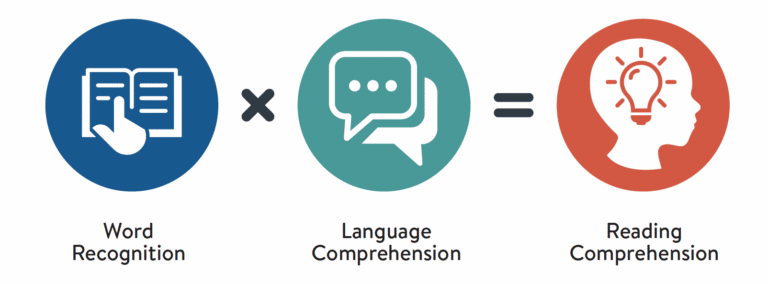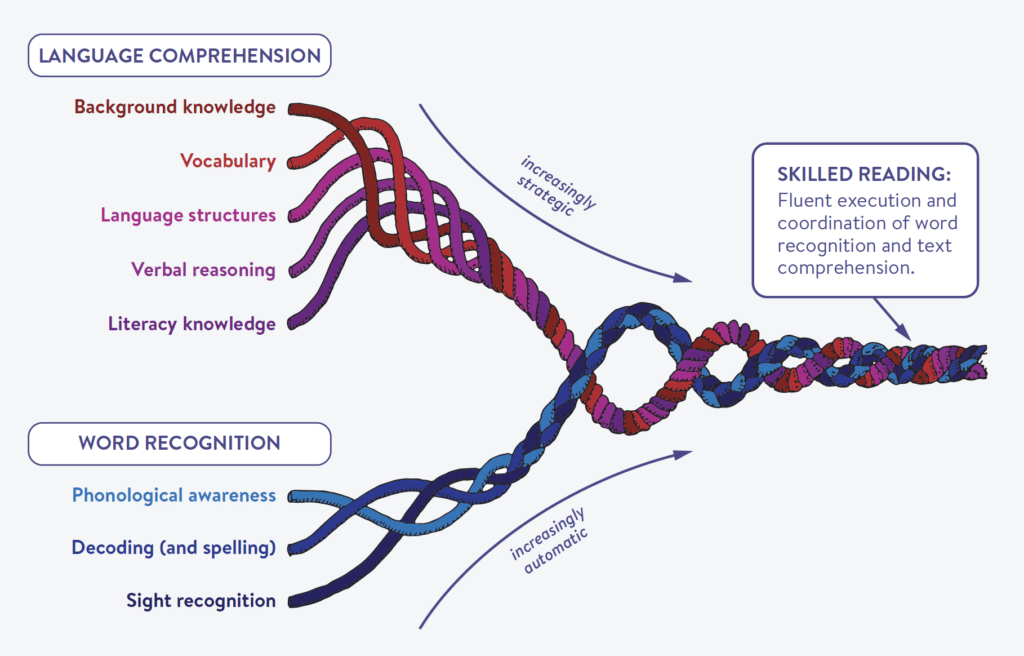Comprehension
Home » Comprehension
Reading comprehension involves understanding the meaning and intent of a written text. It requires the coordination of many cognitive skills and abilities. Successful text comprehension involves the construction of an integrated and coherent representation of the overall meaning of the text, rather than memory for just the literal wording. Reading comprehension has a unique place in the Five Big Ideas as it is both an essential
element of reading instruction in its own right, and the desired outcome of instruction in all
of the elements.
The Simple View of Reading proposes that reading comprehension can be predicted by two key factors – the ability to decode or identify words and the ability to understand what the words are saying. Both need to be encouraged and supported from the onset of reading instruction.

The Simple View of Reading (Gough & Tunmer, 1986)
The factors that comprise the Simple View of Reading are themselves comprised of sets of skills. The Reading Rope (Scarborough, 2001) identifies these skills in more detail and depicts them as becoming intertwined as reading becomes proficient.

Scarborough’s Reading Rope (Scarborough, 2001).
The two skill sets contribute differently to overall reading over time. Oral language comprehension is usually relatively well developed when children begin school (children learning English as an Additional Language or Dialect [EALD] may be an exception), and is unlikely to be a source of difficulty in reading the simple books given to beginning readers. However, for beginning readers, decoding and word recognition will be new, so reading comprehension is almost entirely predicted by word reading in the early school years. Once accurate word reading is established, language comprehension plays a bigger role.
Nonetheless, while children typically have reasonable oral language skills when they start school, they do not have all the language skills in place that are needed for text comprehension. Written texts are different from conversation and require specific cognitive skills. For example, in written language, syntax and vocabulary are more complex, there are no expressive cues like vocal intonations, and written text has to describe the setting and time.
A teacher of reading must know the components of comprehension to assess them and to teach them. Well-informed teachers can help students become better comprehenders.
Key readings
Cain , K., Oakhill, J., & Elbro, C. (2014).
Understanding and teaching reading comprehension: A handbook. Routledge.
Catts, H. W. (2022).
Rethinking how to promote reading comprehension.
American Educator
Duke, N. K., Ward, A. E., & Pearson, P.D. (2021).
The scienceof reading comprehension instruction.
The Reading Teacher
Decoding, reading and reading disability.
Remedial and Special Education
Decoding, reading and reading disability.
In S. Neuman & D. Dickinson (Eds.), Handbook for research in early literacy (pp. 97–110).
